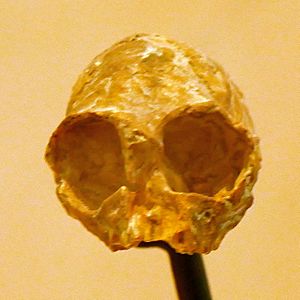Tremacebus facts for kids
Quick facts for kids Tremacebus |
|
|---|---|
 |
|
| Skull of Tremacebus harringtoni | |
| Scientific classification | |
| Genus: |
Tremacebus
|
| Species: |
harringtoni
|
Tremacebus was an ancient type of monkey that lived a very long time ago. It is now extinct, meaning it no longer exists on Earth. This monkey belonged to a group called New World monkeys, which are monkeys found in Central and South America. Tremacebus lived during a period called the Miocene epoch, specifically in the early part of it. Scientists call this time the Colhuehuapian age in the SALMA classification. The most well-known species of this monkey is called T. harringtoni.
What Tremacebus Looked Like
Tremacebus was about 1 metre (3.3 ft) long, which is roughly the size of a small person. It probably looked a lot like a modern night monkey, also known as an owl monkey. Scientists think it might even be an early relative of today's night monkeys.
Eyes and Sense of Smell
However, there were some key differences. Tremacebus's eyes seemed to be smaller than those of modern night monkeys. Scientists used CT scans to look inside its cranium (skull). These scans showed that its olfactory bulb, the part of the brain that helps with the sense of smell, was quite small. This suggests that Tremacebus might not have had a very good sense of smell compared to night monkeys.
Modern night monkeys are active at night, which is why they are called "night monkeys." Their large eyes and good sense of smell help them navigate in the dark. Because Tremacebus had smaller eyes and a weaker sense of smell, scientists believe it might not have been nocturnal (active at night) like its modern relatives. It probably weighed around 1.8 kg (4.0 lb), which is about the same as a small house cat.
Where Tremacebus Lived
Scientists have found only a few fossils of Tremacebus. One important fossil is a skull, which was discovered in a place called the Sarmiento Formation. This area is located in Patagonia, a region in South America that covers parts of Argentina and Chile. Finding these fossils helps us learn more about what life was like millions of years ago.
See also
 In Spanish: Tremacebus harringtoni para niños
In Spanish: Tremacebus harringtoni para niños

